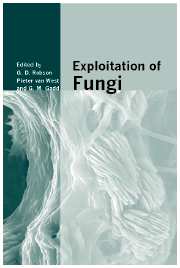Book contents
- Frontmatter
- Contents
- List of contributors
- Preface
- I Comparative and functional fungal genomics
- II Bioactive molecules
- III Protein folding and secretion
- IV Fungal bioremediation
- V Fungal biocontrol of pests
- 14 Fungal control of subterranean pests
- 15 Development of mycoherbicides and evaluation of potential risks (using Stagonospora as a model)
- 16 A novel understanding of the three-way interaction between Trichoderma spp., the colonized plant and fungal pathogens
- 17 Fungal parasites of invertebrates: multimodal biocontrol agents?
- Index
- References
15 - Development of mycoherbicides and evaluation of potential risks (using Stagonospora as a model)
from V - Fungal biocontrol of pests
Published online by Cambridge University Press: 05 October 2013
- Frontmatter
- Contents
- List of contributors
- Preface
- I Comparative and functional fungal genomics
- II Bioactive molecules
- III Protein folding and secretion
- IV Fungal bioremediation
- V Fungal biocontrol of pests
- 14 Fungal control of subterranean pests
- 15 Development of mycoherbicides and evaluation of potential risks (using Stagonospora as a model)
- 16 A novel understanding of the three-way interaction between Trichoderma spp., the colonized plant and fungal pathogens
- 17 Fungal parasites of invertebrates: multimodal biocontrol agents?
- Index
- References
Summary
Several weeds such as the bindweeds Convolvulus arvensis and Calystegia sepium, which belong to the economically most important weeds, are difficult to control with conventional physical and chemical methods. Biological control with fungal biocontrol agents (FBCA) offers a promising alternative. However, the employment of such FBCAs implies not only the identification of highly effective strains and the development of cheap formulation and production techniques, but also an extensive risk assessment including tracking of FBCAs and their toxic metabolites in the environment. Stagonospora convolvuli strain LA39 effectively controls field and hedge bindweed in the field. For this strain formulation and application techniques were developed and currently markers for environmental tracking of the fungus are being designed. A major metabolite produced by LA39 is elsinochrome A (ELA). To assess the risk of ELA production by LA39, different methods, such as toxicity tests, stability tests and methods for environmental monitoring, were developed. Our results revealed that ELA is toxic to a wide array of organisms. However, ELA was never detected in LA39 treated bindweed or crop plants, and the ELA content in the applied biocontrol product is far too low to result in a toxic concentration in the environment. Furthermore, ELA is quickly degraded by sunlight. In conclusion, LA39 is a promising candidate for the development of a successful biocontrol product against bindweed. Harmful side effects of ELA production can be excluded.
- Type
- Chapter
- Information
- Exploitation of Fungi , pp. 275 - 290Publisher: Cambridge University PressPrint publication year: 2007



